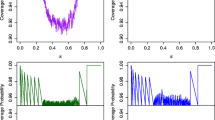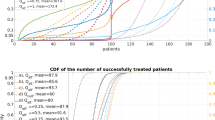Abstract
Adaptive designs are sometimes used in a phase III clinical trial with the goal of allocating a larger number of patients to the better treatment. In the present paper we use some adaptive designs in a two-treatment two-period crossover trial in the presence of possible carry-over effects, where the treatment responses are binary. We use some simple designs to choose between the possible treatment combinations AA, AB, BA or BB. The goal is to use the better treatment a larger proportion of times. We calculate the allocation proportions to the possible treatment combinations and their standard deviations. We also investigate related inferential problems, for which related asymptotics are derived. The proposed procedure is compared with a possible competitor. Finally we use real data sets to illustrate the applicability of our proposed design.
Similar content being viewed by others
References
Atkinson AC (1982). Optimal biased coin designs for sequential clinical trials with prognostic factors. Biometrika 69: 61–67
Atkinson AC and Biswas A (2005). Bayesian adaptive biased-coin designs for clinical trials with normal responses. Biometrics 61: 118–125
Balaam LN (1968). A two-period design with t 2 experimental units. Biometrics 24: 61–73
Bartlett RH, Roloff DW, Cornell RG, Andrews AF, Dillon PW and Zwischenberger JB (1985). Extracorporeal circulation in neonatal respiratory failure: A prospective randomized trial. Pediatrics 76: 479–487
Begg CB (1990). On inference from Wei’s biased coin design for clinical trials (with discussion). Biometrika 77: 467–484
Biswas A (2001). Adaptive designs in phase III clinical trials: controversies and progress. Stat Methods Med Res 10: 353–364
Biswas A and Dewanji A (2004). A randomized longitudinal play-the-winner design for repeated binary data. Aust NZ J Stat 46: 675–684
Brown BW (1980). The crossover experiment for clinical trial. Biometrics 36: 69–79
Campbell MJ and Machin D (1990). Medical statistics: a commonsense approach. Wiley, New York
Carriere KC and Reinsel GC (1992). Investigation of dual-balanced crossover designs for two treatments. Biometrics 48: 1157–1164
Cheng CS and Wu CF (1980). Balanced repeated measurements designs. Ann Stat 8: 1272–1283
Chow S-C and Liu J-P (2000). Design and analysis of bioavailability and bioequivalence studies. Marcel Dekker Inc., New York
Clayton DG (1982). Ethically optimized designs. Br J Clin Pharmacol 13: 49–480
Ebbutt AF (1984). Three-period crossover designs for two treatments. Biometrics 40: 219–224
Gart JJ (1969). An exact test for comparing matched proportions in cross-over design. Biometrika 56: 75–80
Grieve AP (1987). A note on the analysis of the two-period cross-over design when the period-treatment interaction is significant. Biom J 29: 771–775
Grizzle JE (1965). The two-period changeover design and its use in clinical trials. Biometrics 21: 467–480
Hedayat A and Afsarinejad K (1978). Repeated measurements design II. Ann Stat 6: 619–628
Hajek J and Sidak Z (1967). Theory of rank tests. Academic, New York
Hills M and Armitage P (1979). The two-period cross-over clinical trial. Br J Clin Pharmacol 8: 7–20
Huitson A, Poloiecki J, Hews R and Berker N (1982). A review of cross-over trials. Statistician 31: 71–80
Iglewicz B (1983). Alternative designs: sequential, multi-stage, decision theory and adaptive designs. In: Buyse, ME, Staquet, J and Sylvester, RJ (eds) Cancer clinical trials methods and practice oxford, pp 312–334. Oxford University Press, New York
Jones B and Kenward MG (1989). Design and analysis of crossover trials. Chapman & Hall, London
Kenward MG and Jones B (1987). A log-linear model for binary cross-over data. Appl Stat 36: 192–204
Kunert J (1991). Crossover designs for two treatments and correlated errors. Biometrika 78: 315–324
Kushner HB (1997). Optimality and efficiency of two-treatment repeated measurements design. Biometrika 84: 455–468
Laska EM and Meisner M (1985). A variational approach to optimal two-treatment crossover designs: application to carrover effect models. J Am Stat Assoc 80: 704–710
Mainland D (1963). Elementary medical statistics. W.B. Saunders, Philadelphia
Matthews JNS (1987). Optimal crossover designs for the comparison of two treatments in the presence of carryover effects and autocorrelated errors. Biometrika 74: 311–320
Matthews JNS (1989). Estimating dispersion parameters in the analysis of data from crossover trials. Biometrika 76: 239–244
McNemar Q (1947). Note on the sampling error of the difference between correlated proportions or percentages. Psychometrika 12: 153–157
Palmer CR and Rosenberger WF (1999). Ethics and practice: alternative designs for phase III randomized clinical trials. Control Clin Trials 20: 172–186
Prescott RJ (1981). The comparison of success rates in cross-over trials in the presence of an order effect. Appl Stat 30: 9–15
Rao CR (1973). Linear Statistical Inference. Wiley, New York
Rosenberger WF (1996). New directions in adaptive designs. Stat Sci 11: 137–149
Rosenberger WF, Flournoy N and Durham SD (1997). Asymptotic normality of maximum likelihood estimators from multiparameter response-driven designs. J Stat Plan Inference 60: 69–76
Rosenberger WF, Stallard N, Ivanova A, Harper CN and Ricks ML (2001). Optimal adaptive designs for binary response trials. Biometrics 57: 909–913
Rout CC, Rocke DA, Levin J, Gouws E and Reddy D (1993). A reevaluation of the role of crystalloid preload in the prevention of hypotension associated with spinal anesthesia for elective cesarean section. Anesthesiology 79: 262–269
Senn S (1993). Cross-over trials in clinical research. Wiley, New York
Tamura RN, Faries DE, Andersen JS and Heiligenstein JH (1994). A case study of an adaptive clinical trials in the treatment of out-patients with depressive disorder. J Am Stat Assoc 89: 768–776
Wei LJ (1979). The generalized Polya’s urn for sequential medical trials. Ann Stat 7: 291–296
Wei LJ and Durham S (1978). The randomized play-the-winner rule in medical trials. J Am Stat Assoc 73: 838–843
Wei LJ, Smythe RT, Lin DY and Park TS (1990). Statistical inference with data-dependent treatment allocation rule. J Am Stat Assoc 85: 156–162
Zelen M (1969). Play-the-winner rule and the controlled clinical trial. J Am Stat Assoc 64: 131–146
Author information
Authors and Affiliations
Corresponding author
Rights and permissions
About this article
Cite this article
Bandyopadhyay, U., Biswas, A. & Mukherjee, S. Adaptive two-treatment two-period crossover design for binary treatment responses incorporating carry-over effects. Stat Methods Appl 18, 13–33 (2009). https://doi.org/10.1007/s10260-007-0072-6
Published:
Issue Date:
DOI: https://doi.org/10.1007/s10260-007-0072-6




